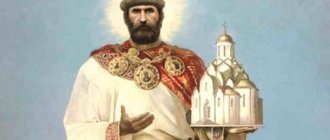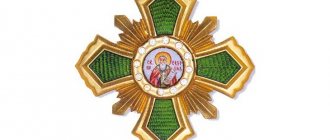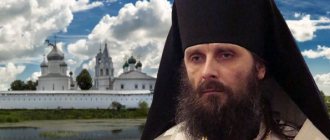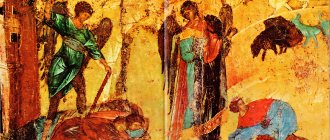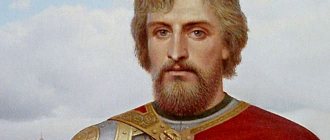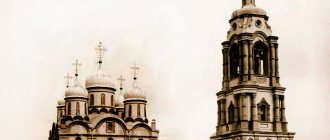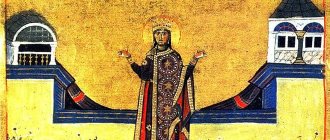| St. blgv. Prince Daniil of Moscow |
Daniil Alexandrovich
(1261 - 1303), Prince of Moscow, blessed Commemoration March 4, August 30 for the discovery of relics, in the Cathedral of Moscow Saints
Born in 1261, he was the youngest, fourth son of St. Alexander Nevsky and Righteous Vassa. When he was two years old, he lost his father. The time of his mother’s repose is not indicated in the chronicles; it is only known that she was buried in the church in honor of the Nativity of Christ in the Vladimir Dormition Monastery (Princess Monastery) and was considered righteous by the surrounding residents.
In 1272 [1] he received Moscow and its surrounding lands as an appanage. The Moscow principality was small and unenviable in those days, but over time, the matured noble prince Daniel strengthened and enlarged it.
Already in 1272, he founded the Krutitsky monastery with a temple in the name of the apostles Peter and Paul. Then the noble prince built a temple on the banks of the Moscow River and a monastery attached to it in the name of his patron, the Venerable Daniel the Stylite.
In 1283, with his brother Andrei, he acted against his older brother, Vladimir. book Dimitri. When Andrei took the grand-ducal table, Daniel acted against him in alliance with his nephew Ivan, Prince. Pereyaslavsky, and uncle Mikhail Tversky (1296).
When in 1293, Grand Duke Andrei Alexandrovich, together with the Tatars called from the Horde, led by Tudan (Dyuden (“Dudenev’s Army”), devastated the Russian cities: Murom, Suzdal, Kolomna, Dmitrov, Mozhaisk, Tver, the noble prince decided to let them into Moscow, to save the people from destruction. There was no strength to fight back. Together with his people, the prince experienced the hardships of ruin and robbery. Defending his rights, Saint Daniel was forced in 1295 to speak out against his brother near a place called Yuryevo Tolchische, but even here the desire for the world won in it, and bloodshed was avoided.
In 1300, when the Ryazan prince Konstantin Romanovich, calling on the Tatars for help, was engaged in secret preparations for a surprise attack on the lands of the Moscow principality, the Monk Daniel went with an army to Ryazan, “by some cunning” defeated the enemy, captured Constantine and destroyed many Tatars ( 1301). This was the first victory over the Tatars, a quiet victory, but wonderful - like the first impulse towards freedom. Having defeated the Ryazan prince and scattered his allies - the Tatars, the noble prince Daniel did not take advantage of the victory to take away foreign lands or take rich booty, as was customary in those days, but showed an example of true non-covetousness, love and brotherly love.
The holy prince never took up arms to seize foreign lands, he never took away property from other princes either by violence or deceit. For this, the Lord expanded the borders of his possessions. John Dimitrievich, prince of Pereyaslavl-Zalessky, nephew of Daniel, meek, pious and benefactor of the poor, respected and loved his uncle. In 1302, dying childless, he transferred his principality to Saint Daniel. The Pereyaslavl land, together with Dmitrov, was the first after Rostov both in the number of inhabitants and in the fortress of the main city. Pereyaslavl-Zalessky was well protected on all sides. Andrei, who had long been “encroaching” on Pereyaslavl, sent his boyars and tiuns to the latter; but Daniel drove them out of there and installed his governors there. The holy prince remained faithful to Moscow and did not move the capital of the principality to Pereyaslavl, which was stronger and more significant at that time. This annexation made the Moscow principality one of the most significant. Here was the beginning of the unification of the Russian land into a single powerful state.
In 1303, the prince became seriously ill. He accepted the great schema and ordered himself to be buried in the Danilov Monastery. Out of deep humility, he wanted to be buried not in the church, but in the general monastery cemetery.
On March 4, 1303, the blessed Prince Daniel died.
Less than 30 years had passed since the repose of the blessed Prince Daniel, when the Danilevsky monastery founded by him was transferred to the Kremlin in 1330, the church was turned into a parish, and the cemetery became secular.
During the time of Grand Duke John III (1462 - 1505), the Monk Daniel reminded forgetful descendants of himself. An unknown person appeared to the young man from the entourage of the Grand Duke and said: “Do not be afraid of me - I am a Christian and the lord of this place, my name is Daniel, Prince of Moscow, by the will of God I was placed here. Tell Grand Duke John from me: you console yourself, but you have forgotten me, but God has not forgotten me.”
From that time on, the Grand Duke established the singing of cathedral memorial services for relatives - the princes. During the time of Tsar Ivan the Terrible, at the tomb of the Monk Daniel, the dying son of a Kolomna merchant was healed. The Tsar, struck by the miracle, restored the ancient Danilov Monastery and established that the Metropolitan and the Holy Cathedral should annually conduct a procession of the cross to the burial place of the blessed prince and serve a memorial service there.
In 1652, the blessed Prince Daniel was glorified by the discovery of the holy incorruptible relics, which on August 30 were transferred to the church in honor of the Holy Fathers of the Seven Ecumenical Councils. The holy relics were placed in a shrine “for the glorification of the Holy Trinity and for the healing of the infirm.”
Metropolitan of Moscow Platon (Levshin) (+ 1812) in the Life of the Holy Prince, compiled by him, writes:
“This original founder laid the foundation for the present greatness of Moscow, paving for this with quiet feet only a small path. For, like any building, constructed not with extreme haste, but only with great skill and diligence, it receives special hardness and remains indestructible for a long time; and just as a tree, growing for many centuries, having first begun with a small twig, gradually thickens, and its branches spread far around, so this city had to grow from small but solid beginnings, so that its first shine would not darken the eyes of the envious and so that at first not to be shaken and fall sooner than it has grown in height. This is how the founder prepared this great city, giving it, although small, but not interrupted by any breath of wind, and gave the great glory of its exaltation to his son, Grand Duke John Danilovich, nicknamed Kalita.
short biography
According to information from the chronicles, Daniil Alexandrovich was born in 1261. He was named after Daniel the Stylite. The boy lost his father at the age of two and therefore his mother, Princess Alexandra, was involved in his upbringing. Soon after her husband's death, she decided to serve in the Assumption Monastery. The boy’s uncle, Yaroslav, became Daniel’s guardian.
From a young age, the future prince was taught science and military affairs. Daniel showed interest in culture and faith. He went to church to listen to singing and church prayers. When Daniil was 11 years old, Yaroslav died. The boy had to move to Moscow to take over the management of the principality. The first prince of Moscow, Daniil Alexandrovich, occupied the throne until his death in March 1303.
Death of the Grand Duke of Moscow
In 1303, Prince Daniil was overcome by a serious illness. Shortly before his death, he decided to become a monk. After accepting monasticism, Daniil of Moscow bequeathed to bury his ashes in the Danilov Monastery. The humble prince wished to be buried in the soil of the monastery cemetery, and not in the church.
The noble ruler died on March 4, 1303. The Grand Duke left behind 10 children (9 sons and 1 daughter). Having matured, many of his heirs continued their father's endeavors.
The body of the newly deceased was buried in accordance with his last will on the territory of the Danilov Monastery. There are two versions regarding the specific burial place of Daniel:
- according to the first, the Grand Duke was buried in the brotherly cemetery of the Danilov Monastery;
- the second names the Archangel Cathedral, which belongs to the Moscow Kremlin, as his final resting place.
In 1652 the relics of the prince were discovered. At the direction of Tsar Alexei Mikhailovich, they were transferred to the Church of the Seven Ecumenical Councils, belonging to the Danilov Monastery. During Soviet times, from 1917 to 1930, the relics were kept by the Trinity Cathedral. In 1930, the incorrupt remains were again transferred, this time to the Church of the Resurrection of the Word. After this temple was closed, their new location became unknown.
Today, the Danilov Monastery has several fragments of the relics of the blessed prince, which are placed in icons, a shrine and a reliquary. Daniel of Moscow himself was canonized as a saint in 1791.
Years of reign
Moscow Prince Daniil Alexandrovich began to rule in 1272, when he was 11 years old. Due to his young age, the prince could not make important decisions on his own. In the first years of his reign, he was helped by close boyar mentors. Soon he refused their help and began to govern the Principality of Moscow on his own.
Domestic policy
Daniil Alexandrovich was actively involved in the development of the principality. There are several main areas of its activity:
- Development of culture and construction of new temples. In the first year of his reign, the prince built a temple on Krutitsy. Ten years later, Daniel founded a monastery in Moscow.
- Strengthening the principality. Daniel did not like to fight, but at the same time he did not forget about defensive buildings. On the territory of the Principality of Moscow, fortresses were erected to protect and defend the borders.
- Stopping internal strife. Daniel did everything to unite and strengthen the principality. He was one of the organizers of the Dmitrov Gathering of Princes.
Additional Information! Another achievement of the prince’s competent domestic policy is the strengthening of Moscow’s political influence. Thanks to Daniil Alexandrovich, Moscow became the center of Rus'.
Foreign policy
Daniil Alexandrovich was a peace-loving person and this affected his foreign policy. He rarely took part in wars and resolved conflict situations peacefully. Despite this, he periodically had to demonstrate strength.
In 1282 he supported the prince of Tver and fought with him for the Vladimir throne. Daniel later stopped the war. He managed to resolve the fraternal feud peacefully and stop the bloodshed. Daniel also supported his brother Dmitry, who ruled in Vladimir.
The year 1293 turned out to be difficult for Daniel. His brother Andrei brought the Golden Horde to the territory of the principality. They burned Moscow and killed many local residents. Daniel did not abandon the people in trouble and quickly rebuilt the destroyed city. The Moscow prince did not forget about this incident and decided to take revenge on Andrei. In the late 90s of the 13th century, he gathered an army to fight him. The confrontation lasted two years. As a result, the brothers stopped the war and made peace.
The struggle for the great reign
With the death of the Tver prince Yaroslav, a new stage in the history of Ancient Rus' began. Initially, Daniel practically does not appear on the pages of the chronicles - the ancient chroniclers are completely immersed in the activities of Alexander’s other sons. At that time, Dmitry and Andrei fought for the great reign, and the former initially settled in Vladimir.
Prince Dmitry Alexandrovich. Drawing by V. Vereshchagin. (en.wikipedia.org)
In the first years of his reign, Dmitry tried to establish his influence in freedom-loving Novgorod, following the example of his father. Andrei did not fail to take advantage of this and tried to occupy the grand-ducal table with the help of the Tatars. Dmitry, frightened by this development of events, fled to Sweden, but soon returned and reoccupied Vladimir, taking advantage of the absence of his brother - he was in the Horde on business.
At this time, Novgorod had already sworn allegiance to Andrei. Dmitry with his regiments tried to restore his influence there and approached Torzhok. A fairly broad coalition of princes almost immediately formed against him, which included young Daniel. It is with these events that his first appearance on the pages of chronicles as a Moscow prince is connected.
The opposing troops met near Dmitrov, but were in no hurry to start the battle. They spent 5 days at the negotiating table until they agreed not to let the matter lead to bloodshed. The Moscow prince took an active part in concluding the agreement. These events showed that Daniel chose a wait-and-see and peaceful approach towards his rival brothers.
Results and results of the board
During the years of his reign, Danil managed to achieve some results. His achievements include:
- Founding of the Moscow dynasty of princes, which ruled the principality after his death.
- Expansion and strengthening of the Moscow Principality.
- Initiated the Dmitrov Princely Congress to resolve internal strife and unite the princes in the fight against the Golden Horde.
- Defended the principality from Tatar raids.
If we briefly summarize the reign of Daniil Alexandrovich, we can say that he was truly a wise prince. He managed to unite the Moscow principality, strengthen it, stop internal conflicts and end long-term civil strife.
The ruin of Moscow
After the events near Dmitrov, Daniil again disappears from the sight of chroniclers. Then the rivalry between the Alexandrovichs entered a “cold phase,” but disputes arose every now and then with the Tver branch of the Rurikovichs. Historians believe that Daniel periodically moved from camp to camp, maneuvering between rival relatives. This allowed him to divert the threat from his native small principality, which, however, was not always possible.
In 1293, Andrei Alexandrovich tried to use the change of power in the Horde for his own purposes and went to the new Khan Tokhta to campaign for his candidacy for the grand ducal throne. Daniil was unlucky at that time to act together with Dmitry - as a result, the punitive expedition of the Tatars, “Dudenev’s Men,” did not bypass the Moscow principality. The chronicler recorded these events in this way: “And so I came to Pereyaslavl and stood near the city for many days, when there were no more people, they ran out of Pereyaslavl, and came to Moscow, and the Moscow Danil was deceived, and thus entered Moscow, and did the same thing as and I judged and Volodymyr, and the rest of the city, and took all Moscow and the volosts, and the villages" .
Apparently, Daniel tried at the last moment to come to an agreement with the enemy, but the eastern cunning overcame the prince.
13th century Mongol horseman. (wikiwarriors.org)
During the Horde expedition, Dmitry fled to Pskov - from there, if anything happened, he could easily flee to Sweden. After the Tatars left, he tried to move to Tver, but Andrei intercepted him on the way. Despite the difficult rivalry, the brothers made peace - most likely, Dmitry even remained the Grand Duke. But he did not have time to get to Vladimir. In 1294, he died near Volokolamsk, having not recovered from the heavy blows of fate.
So, Andrei Alexandrovich achieved his cherished dream - he became the Grand Duke.
Memory in culture and church
At the end of the 18th century, Daniel was canonized. The official days of veneration are March 4 and August 30.
Daniil Alexandrovich is not forgotten even today. Dmitry Balashov wrote a novel about him, “The Youngest Son.” It tells about the period of the prince's reign and the key events that took place during those times. This is a work of fiction and therefore contains both historical and fictional characters.
In Moscow, a monument to the prince was erected, located on the Serpukhov Outpost Square. Its creation was carried out by famous sculptors V. Mokrousov and A. Korovin.
Mikhail Yaroslavovich Khorobrit. Years of life:? - 1248 Prince of Moscow : 1246 - 1248 Grand Duke of Vladimir: 1248 - 1248 Boris Mikhailovich (d. 1263) - son of Mikhail Yaroslavich the Brave. Prince of Moscow : 1248 - 1263
Died in 1263 Daniil Alexandrovich
Daniil Alexandrovich
Daniil Alexandrovich (1261 - March 4, 1303, Moscow) - the youngest son of Alexander Nevsky, the first appanage prince of Moscow (from 1263, actually from 1276);
the ancestor of the Moscow line of Rurikovichs: Moscow princes and kings. Prince Daniil of Moscow was born in Vladimir in 1261. He was the fourth and youngest son of Grand Duke Alexander Yaroslavich Nevsky and the righteous Princess Vassa, daughter of Bryachislav, Prince of Polotsk. Daniel was named after Saint Daniel the Stylite, whose memory is celebrated on December 11, therefore, Prince Daniel was born in November-December. The Laurentian Chronicle mentions the year of Daniel’s birth, “a son was born to Alexander, and he named him Danil,” under the year 6769 (1261). At the age of two, Daniel lost his father (his father went to a distant horde, to the Tatar Khan, to appease him; on the way back, the holy noble Grand Duke Alexander Nevsky fell ill and, before reaching Vladimir, died in Gorodets on November 23, 1262). Soon his mother also died (the time of his mother’s repose is not indicated in the chronicles, it is only known that she was buried in the cathedral of the Vladimir Dormition (Princess) Monastery, and the surrounding residents considered her righteous). So Saint Daniel was left an orphan early and did not receive his share of the inheritance for a long time; His elder brothers, who had taken possession of both the grand princely power and all the regions of their father, did not devote anything to Daniel for a long time. Young years The Tver charter of 1408 tells about the education of the Tver prince Yaroslav III Yaroslavich, brother of Alexander Nevsky, little Daniil and about the management of the Moscow tiuns of the Grand Duke Yaroslav, intended for Daniil, for seven years, while he occupied the grand-ducal table in Vladimir: from 1264 to his death in 1271. Marriage and children
The name of Daniel's wife is not known.
Children: Yuri Daniilovich (d. 1325) - Moscow prince in 1303-1325, Grand Duke of Vladimir in 1319-1322. (as Yuri III), Prince of Novgorod in 1322-1325. Ivan Daniilovich (Kalita; 1288-1340) - Prince of Moscow from 1325-1341, Grand Duke of Vladimir from 1328-1341, Prince of Novgorod 1328-1337. Alexander Daniilovich (d. 1322) Afanasy Daniilovich (d. 1322) - Prince of Novgorod (1314-1315, 1319-1322). Boris Daniilovich (d. 1320) - Prince of Kostroma since 1304. When Daniil was 10 years old, in 1272, his brothers allocated for him to reign the poor and insignificant Moscow principality - the worst of the legacies of Alexander Nevsky, compared with Vladimir and Pereyaslavl , Suzdal and other principalities. In 1272 he founded the Krutitsky monastery with a temple in the name of the apostles Peter and Paul. OK. 1276 - the emergence of the Moscow Principality (1276 - 1547), capital Moscow. Prince of Moscow: 1272/1276 - 1303.
Policy
Daniil participated in the struggle of his brothers, princes Dmitry Pereyaslavsky and Andrei Gorodetsky, for the Great Reign of Vladimir and for the right to reign in Novgorod. Inevitably drawn into the civil strife of the princes, Prince Daniil Alexandrovich showed himself to be a peace-lover. In 1282, together with the Tver prince Svyatoslav Yaroslavich, he united the Moscow troops with the troops of his brother Andrei, who fought for the great reign of Vladimir against another brother, Dimitri; but at the first meeting near the city of Dmitrov, the armed men made peace, and no blood was shed. From 1283 he acted on the side of Prince Dmitry, who became the Grand Duke of Vladimir. In 1293, Andrei treacherously led hordes of Tatars, led by Duden (“Dudenev’s Army”), who plundered and devastated many Russian cities: Murom, Suzdal, Kolomna, Dmitrov, Mozhaisk, Tver. In 1293, Moscow was taken by the army of the Tatar prince Tudan. Holy Prince Daniel allowed them into Moscow to save the people from death. There was no strength to fight back. Daniel did not abandon his people during this difficult time. Together with his people, the prince experienced the hardships of ruin and robbery. And when the enemies left the city, leaving behind ashes, Daniel distributed his personal property to the affected citizens. Prince Andrei, supported by the Tatars, began to rule in Vladimir. After the death of Prince Dmitry (1294), Daniil Alexandrovich led the Moscow-Pereyaslav-Tver alliance against Prince Andrei. When Andrei became the Grand Duke of Vladimir, quarrels began between the Russian princes in 1296; but Andrei then admitted that Prince Daniel was right, and bishops Simeon of Vladimir and Ishmael of Sarsk convinced the princes in Vladimir to end the quarrel peacefully at the congress. When, after that, Andrei wanted to take possession of Pereyaslavl-Zalessky with his army, Daniel, Prince of Moscow, together with Prince Mikhail of Tver, met Andrei with a strong army near a place called Yuryevo Tolchishche - and after negotiations peace was concluded. In 1301 he took part in the Dmitrov Congress of Russian Princes. The grandson of Alexander Nevsky, the son of his elder brother Dimitri, the nephew of Daniil, Prince Pereyaslavsky and Dmitrovsky, Ivan received powerful neighbors in Dmitrov - princes Andrei Vladimirsky, Mikhail Tversky and Daniil of Moscow. At this meeting, Saint Daniel convinced everyone to make peace and stop all civil strife.
Expansion of domains
The increased political influence of Moscow was evidenced by the participation of Prince Daniil Alexandrovich in the struggle for Veliky Novgorod (1296), where he was invited to reign in 1296. In 1300, Daniil Alexandrovich successfully fought with Ryazan, capturing Kolomna (1301). After the death of Prince Ivan Dmitrievich Pereyaslavsky (1302), he annexed Pereslavl to the Moscow Principality.
Construction
Under Daniil Alexandrovich,
the Epiphany Monastery (1290s) and Danilov Monastery (late 13th century) were founded in Moscow, where the first archimandry was established.
Burial place
There are two versions about the place of his burial: One goes back to the parchment Trinity Chronicle that burned in 1812 in Moscow occupied by the French. At one time, N.M. saw this chronicle. Karamzin, who made an extract from it about the death of Daniil Alexandrovich. This extract ended with the words: “it was laid down in the church of St. Mikhail in Moscow." Thus, according to the Trinity Chronicle, the place of Daniel’s burial was the Archangel Cathedral in the Moscow Kremlin.
Archangel Cathedral of the Moscow Kremlin
The second version is set out in the Degree Book.
It states that Daniel was buried in the brotherly cemetery of the Danilov Monastery. Memory and veneration
In 1652, the discovery of the prince’s relics took place; according to E.E. Golubinsky, in 1791 he was canonized for local veneration as the holy noble prince Daniil of Moscow. Days of remembrance: March 4 and August 30 (discovery of relics) according to the Julian calendar. The name of Prince Daniil is borne by the Danilov Monastery in Moscow, which he founded, located near the monastery, Danilovskaya Square, Danilovskaya and Novodanilovskaya embankments, Danilovsky Val, as well as the city of Danilov in the Yaroslavl region.
Monument to St. Prince Daniil of Moscow
In 1997, a monument to Prince Daniil of Moscow, the work of sculptors A. Korovin and V. Mokrousov, and architect D. Sokolov, was erected on the Serpukhov Outpost Square in Moscow.
Chapel of the Holy Blessed Prince Daniil of Moscow on Serpukhovskaya Zastava Square
On September 4, 1997, on the eve of the celebration of the 850th anniversary of Moscow, a monument to the Holy Blessed Prince Daniil of Moscow was opened and consecrated on Tula Square. On March 17, 1998, a chapel was consecrated on Tula Square in honor of the Holy Blessed Prince Daniel of Moscow. It was recreated according to a new architectural design near the site of the original chapel, which was demolished after the revolution and had a 300-year history. By resolution of His Holiness Patriarch Pimen and the Holy Synod of December 28, 1988, the Order of the Holy Blessed Prince Daniel of Moscow of 3 degrees was established.
In Nakhabino, near Moscow, which is considered the historical center of the engineering troops of the Russian Defense Ministry, the Temple of Daniel of Moscow, who is the patron saint of the Russian engineering troops, was built.
Church of Daniel of Moscow in Nakhabino
Epiphany Monastery
The Novgorod Chronicle tells the following about the foundation of the monastery: “From 1296 to 1304 there was a monastery of the wonderful Epiphany, and in the chapel of the Annunciation of the Most Pure Mother of God in Moscow for the trade, God's blessing and the building of the blessed and pious Grand Duke Daniil Alexandrovich of Vladimir and Novgorod and Moscow and all Rus', this most honorable monastery of the Epiphany was made in the days of his state...” Church traditions tell that one of the abbots of the monastery was Stephen, the elder brother of St. Sergius, abbot of Radonezh, and that the future Metropolitan Alexy took monastic vows here and labored for a long time. In 1340, under Ivan Kalita, the first stone building of the monastery was laid - the four-pillar Epiphany Cathedral. It was destroyed in 1451 during the invasion of the Horde prince Mazovsha, when most of the Moscow settlement burned down. Restored under Vasily II and somewhat renovated under Ivan III (in particular, a new refectory appeared), the monastery was again badly damaged in 1547 during the Great Moscow Fire. And in 1571, Ivan the Terrible had to rebuild the Epiphany Monastery after the campaign of the Crimean Khan Devlet-Girey against Moscow. During the Time of Troubles, the monastery again suffered disasters (it suffered especially in 1611-1612), and almost immediately after his accession to the throne, the new Tsar - Mikhail Fedorovich - began to rebuild the monastery. In 1624 a new stone cathedral was built. The monastery cathedral was built in 1693-1696. In 1685, a school was founded in the monastery by the brothers Ioannikiy and Sophrony Likhud, which a couple of years later moved to the neighboring Zaikonospassky Monastery. This is how the famous Slavic-Greek-Latin Academy was born. In 1693-1696. The Epiphany Cathedral, which has survived to this day, was built in the style of the so-called. “Naryshkin Baroque”, in the lower (basement) part of which part of the building of 1624 has been preserved. Later, the arches of the poklet were laid. In 1737, the monastery was again seriously damaged by fire. The monastery buildings were restored under Archimandrite Gerasim, who by 1742 built, in addition to the second gate, a new gate church of Boris and Gleb with a bell tower. In 1747, the cathedral received a northern aisle in the name of St. George the Victorious, and in 1754 a southern aisle in the name of the Apostle James Alpheus. A bell tower was also added. In 1764, all monastic lands were secularized. In 1782, the church was repaired and painted, and its new parts were decorated with stucco. In 1788, the monastery became the seat of the suffragan bishop of the Moscow diocese. Since 1865, it was ruled by bishops - vicars of the Moscow Metropolis. The monastery began to flourish especially since 1866, when particles of the holy relics of the martyrs: Panteleimon, Tryphon and others, as well as the miraculous icon of the Mother of God, called the “Quick to Hear”, were brought from Mount Athos and placed in the cathedral church. The penultimate abbot of the monastery was Bishop Tryphon (Turkestan). In 1873, a chapel was built in the cathedral in the name of St. Panteleimon. In the beginning. 1920s the monastery was closed. During the Great Patriotic War, a shot down German fighter plane destroyed the head of the temple when it fell. The chapter was restored in the 1990s.
Cathedral of the Epiphany Monastery
The monastery cathedral was built in 1693-1696.
See Danilov Monastery. Moscow princes. Prince Yuri Dolgoruky. From 1125 the capital was in Suzdal, 1120-1149. - Prince of Rostov-Suzdal. Prince Michael II Yaroslavich Khorobrit. 1246 - 1248 - Prince of Moscow. Prince Boris Mikhailovich. 1248-1263 - Prince of Moscow. Moscow Principality Prince Daniil Alexandrovich. 1263/1276 - 1303 - Prince of Moscow. Prince Yuri III Daniilovich. 1303 - 1325 - Prince of Moscow. Moscow State The origin of Moscow statehood.
Ivan I Kalita.1322/1325 - 1340 - Prince of Moscow. Saint Metropolitan Theognostos. mind. 1353 Simeon Ivanovich Proud. 1340 - 1353 Ivan II Ivanovich the Red.1353-1359. Copyright © 2015 Unconditional love
Personal life
The name and origin of the prince's wife are not found in surviving primary sources. However, Pyotr Vladimirovich Dolgorukov, who compiled the “Russian Genealogical Book” in the 19th century, wrote it down under the name of Evdokia Alexandrovna.
Ivan Kalita, son of Daniil of Moscow
Nothing is known reliably about Daniel’s daughters either, because the stories of women in that era were rarely recorded in the chronicles. And the prince had five sons: Yuri, Alexander, Boris, Ivan and Afanasy.
What does the holy prince help with?
Daniil of Moscow is revered by a huge number of people who occupy management positions and want to become wise and respected leaders. Prayer performed in front of the icon of the holy prince helps:
- in conflict situations, everyday troubles;
- when choosing a good boss;
- with tense relations with management;
- in resolving issues regarding the purchase of housing and the sale of a house;
- in litigation, resolution of land disputes;
- if necessary, to protect the house from robbers and ill-wishers.
The noble prince has long been considered the defender of the Russian land. They resort to the help of this Saint in difficult times for the Fatherland, in the event of unrest and crisis periods.
When reading an akathist or addressing Daniel of Moscow with his own words, every Orthodox Christian needs to remember: the Saint always takes the side of the highest justice. Only those people who sincerely strive to defend the truth and defend a godly cause can expect support from him.
Prayers to Daniil of Moscow
Prayer 1
Oh, saint of God, holy and faithful Prince Daniel, the fragrant flower of the garden of Christ, the gentle star of the church sky, the heavenly mind of our earth, the city of Moscow and our empire wise to the creator. Warm to God, prayerful, quick to help, merciful in need, we fall to you and pray to you: be our representative before the Throne of God’s glory, ever vigilant. Gather us together, so that everyone can share in the sorrow of their neighbor with unhypocritical love. Our minds are heavenly, yes, having rejected the heavy yoke of earthly cares, let us love the light burden of Christ’s Gospel. Open our eyes, so that we may see the imperishable beauty of the Lord and may we not be alienated from the life of God. May the quietness of the Spirit of God guard our hearts. May the spring of repentance brighten our affairs. Merciful and generous prince, save our country, your city and those who pray to you here from all misfortunes, from enemies visible and invisible, from destruction and famine, from internecine strife and sudden death. Open to us the doors of God’s mercy and deliver us from all evil. Taking refuge under the strong cover of your goodness, we pray: give us a quiet refuge in times of sorrow. Encourage us with your prayers. Keep us from the falls of sin and error, so that with a contrite heart, a humble spirit in sorrow and joy, we cry: Lord, through the intercession of Thy Holy One, have mercy on us. Amen.
Prayer 2
High praise to the Church of Christ, unassailable wall of the city of Moscow, divine affirmation to the Russian powers, like Prince Daniel. Flowing to the race of your relics, we earnestly pray to you: look upon us, who sing thy memory and come running with faith under the shelter of your prayers. Shed your warm intercession to the Savior of all, for may he establish peace in our country, its cities and towns, and may this monastery preserve goodness, piety and love in your people, planting malice , civil strife and corruption of morals, eradicating; Grant to us all all that is good for temporary life and eternal salvation through your prayers, so that we glorify the wondrous Christ our God in His saints forever and ever. Amen.
Prayer 3
Oh, Reverend Prince Daniel, flowing to your icon, we fervently pray to you: look upon us (names), who come running with faith under the shelter of your prayers. Shed your warm intercession to the Savior of all, for may this parish be established in peace and may this temple preserve goodness, piety and love in the Orthodox people, planting malice, civil strife and corruption of morals uprooting; Grant to us all all that is good for temporary life and eternal salvation through your prayers, so that we glorify the wondrous Christ our God in our saints, together with the Father and the Holy Spirit forever and ever. Amen.
